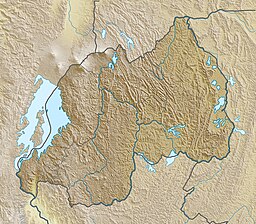
Back Kivumeer Afrikaans بحيرة كيفو Arabic بحيرة كيفو ARZ Llagu Kivu AST Kivu Azerbaijani Ківу Byelorussian Ківу (возера) BE-X-OLD Киву Bulgarian किवू झील Bihari কিভু হ্রদ Bengali/Bangla
| Lake Kivu | |
|---|---|
 Satellite image of Lake Kivu courtesy of NASA. | |
| Coordinates | 2°0′S 29°0′E / 2.000°S 29.000°E |
| Type | Rift Valley lakes, meromictic, limnically active lake |
| Primary outflows | Ruzizi River |
| Catchment area | 2,700 km2 (1,000 sq mi) |
| Basin countries | Rwanda, Democratic Republic of the Congo |
| Max. length | 89 km (55 mi)[1] |
| Max. width | 48 km (30 mi)[1] |
| Surface area | 2,700 km2 (1,040 sq mi)[1] |
| Average depth | 240 m (787 ft) |
| Max. depth | 480 m (1,575 ft) |
| Water volume | 648 km3 (155 cu mi) |
| Surface elevation | 1,460 m (4,790 ft) |
| Islands | Idjwi |
| Settlements | Goma, Congo Bukavu, Congo Kibuye, Rwanda Cyangugu, Rwanda |
Lake Kivu is one of the African Great Lakes.[2] It lies on the border between the Democratic Republic of the Congo and Rwanda, and is in the Albertine Rift, the western branch of the East African Rift. Lake Kivu empties into the Ruzizi River, which flows southwards into Lake Tanganyika.[3] In 1894, German explorer and officer Gustav Adolf von Götzen was the first European to discover the lake.

In the past, Lake Kivu drained toward the north, contributing to the White Nile. About 13,000 to 9,000 years ago, volcanic activity blocked Lake Kivu's outlet to the watershed of the Nile.[4] The volcanism produced mountains, including the Virungas, which rose between Lake Kivu and Lake Edward, to the north.[5] Water from Lake Kivu was then forced south down the Ruzizi. This, in turn, raised the level of Lake Tanganyika, which overflowed down the Lukuga River.[4]
Lake Kivu is one of three lakes in the world, along with Lake Nyos and Lake Monoun, that undergo limnic eruptions (where overturn of deepwater stratified layers releases dissolved carbon dioxide (CO2). The lake's bottom also contains methane (CH4), meaning if a limnic eruption occurs, the lives of the two million people living nearby would be in danger.
- ^ a b c Lagassé, Paul, ed. (2000). The Columbia Encyclopedia (6 ed.). Columbia University Press. p. 1539. ISBN 978-0787650759.
- ^ Cite error: The named reference
readersnaturalwas invoked but never defined (see the help page). - ^ Cite error: The named reference
:0was invoked but never defined (see the help page). - ^ a b Danley, Patrick D.; Husemann, Martin; Ding, Baoqing; Dipietro, Lyndsay M.; Beverly, Emily J.; Peppe, Daniel J.; et al. (2012). "The Impact of the Geologic History and Paleoclimate on the Diversification of East African Cichlids". International Journal of Evolutionary Biology. 2012: 1–20. doi:10.1155/2012/574851. PMC 3408716. PMID 22888465.
- ^ Clark, J. D. (1969). Kalambo Falls Prehistoric Site, Volume 1. London: Cambridge University Press. p. 34. Retrieved 16 January 2013.
© MMXXIII Rich X Search. We shall prevail. All rights reserved. Rich X Search


